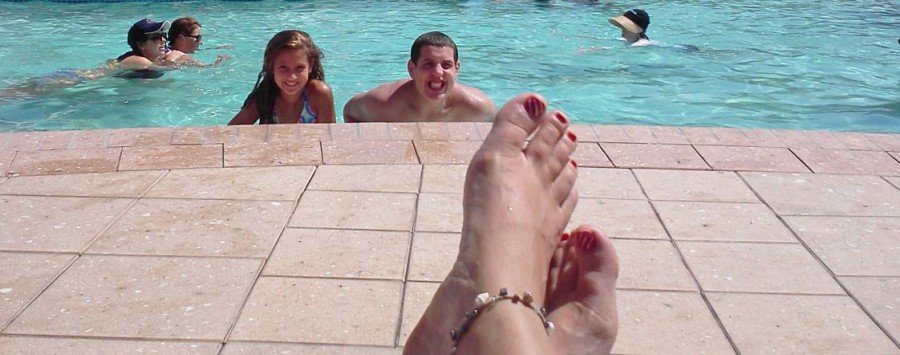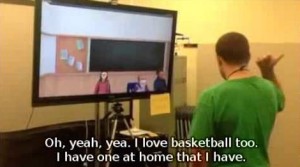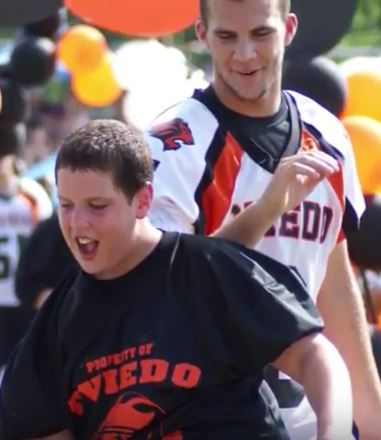Picture yourself, a humble, sincere, vaguely panic stricken education student just about to step in front of a class room full of middle school students for the very first time. You have the best that a college education can give you and a handful of memories of your own school experiences (which probably doesn’t help) and an evaluator watching in the wings.
Extra strength antiperspirant, anyone?
Now imagine yourself seated in in that same class room, surrounded by young people your own age. They’re laughing and talking and coughing and moving in their seats, tapping toes and rummaging through backpacks while cell phones ring and the air conditioner hums and clatters in the background as the fluorescent lights overhead put out a high pitched buzz. The sound of heels clicks on the floor outside the door as people walk by, chattering. Someone is writing with a squeaky erase marker on the dry board on the wall while the person closest to you slurps from the bottom of their foam cup through a straw. A chair scrapes across the floor as someone stands up and the chains on his jacket jingle when he does. Behind you, someone pulls open a crackly snack bag and the smell of Doritos rises into the air. Every scent and sound is equally strong. Each one demands your attention. Nothing gets filtered out.
Then someone jostles you, squeezing by and calls your name. You look up at their face. It fractures slightly into a thousand pieces, each shifting slightly differently as the mouth and eyes and jaw bone move. The confusion is overwhelming. You can barely process what they’re actually saying, looking at that bizarre spectacle. You look away instantly, anywhere else but at that face, but the painful sensation of that glance stays with you, and you start to rock back and forth to help push the feeling away. It doesn’t help much.
And now, it’s time to be social and learn!
An Educator and an Engineer walk into a bar….
Stop laughing. It could happen.
In fact, at the University of Central Florida, it did.
UCF Engineering Smart Guy: Why not give these brand new teachers a chance to get up in front of some computer generated students first? You know, test it out with software students…control the environment.
UCF Educator Brilliant Person: Uh. If we’re controlling the environment for them, how does that train them to control the classroom themselves? Where’s the random? Where’s the real life?
UCF Engineering Smart Guy (beginning to sweat with excitement): So, it needs to be real! And digital! Really really digitally real!
UCF Educator Brilliant Person: Uh…have you seen “Avatar?”
>Phone rings<
Speakerphone: “Hello? This is Bill and Melinda Gates. We felt the earth move here in Redmond, WA, and we have a grant for you.”
 And thus was born “TeachLivE, at least in my fevered imagination. A research team at UCF has created a virtual classroom peopled by avatars. (An avatar is a computer version of a real person. The viewer sees the computer version on a screen while the real person controls the avatar behind the scene. And no, they’re not blue.)
And thus was born “TeachLivE, at least in my fevered imagination. A research team at UCF has created a virtual classroom peopled by avatars. (An avatar is a computer version of a real person. The viewer sees the computer version on a screen while the real person controls the avatar behind the scene. And no, they’re not blue.)
So now, before throwing a tender young teacher to the wolves who are our darling middle school offspring, the teacher can enter a sort of educational flight simulator full of desks and digital students, just as if standing at the head of a classroom. Every one of those avatar students is “alive” in that a real person’s body motions and speech are being reflected in real time on the screen. Each avatar has a name, personality and a back story. And they react based on the teacher’s actions.
 Of course, the avatar isn’t really a student. It’s controlled by a trained interactor, and it’s a highly controlled environment: a student teacher’s lesson plan has to be submitted in advance. This results in intense immersion experiences for the teachers. In fact, it’s so intense, no student teacher is allowed to be in the virtual classroom for more than 10 minutes. I’m not entirely clear on what happens if they go over 10 minutes but it may account for the slight burnt smell I noticed hanging over the lab.
Of course, the avatar isn’t really a student. It’s controlled by a trained interactor, and it’s a highly controlled environment: a student teacher’s lesson plan has to be submitted in advance. This results in intense immersion experiences for the teachers. In fact, it’s so intense, no student teacher is allowed to be in the virtual classroom for more than 10 minutes. I’m not entirely clear on what happens if they go over 10 minutes but it may account for the slight burnt smell I noticed hanging over the lab.
TeachLivE is now being used all over the country to train new and experienced teachers. Go to Youtube. You’ll see.
A Teacher and a Teen with Autism walk into a virtual classroom….
CJ’s teacher has been hard at work on her master’s degree at UCF. This means she’s smart, and she knows people. She and one of the TeachLivE creators (Educators and Engineers again, though I don’t know if it was in a bar) got the idea to bring her special needs class into the virtual classroom…you know…just to see how they would react to the avatars. Some of her kids are more social and attend mainstream classes. Some fall in the middle. And one was completely non-verbal. But no matter where on the line, all her students struggle to engage or show social interest. So we already know how they react to people.
Except that these “people” aren’t really people. And these kids aren’t just any kids. The Engineer and the Educator wondered what would happen.
The result was a show stopper. Each student entered and one by one took a glance at the screen, stopped, focused and LOOKED. Heads up, shoulders back, eyes front, gaze steady. And one by one, the educators in the room came to a halt, spellbound. The room fell silent. Except for the kids…who started talking.
Every single one of the kids engaged unprompted with the avatars. They took turns. They initiated. They asked questions. They waited for answers. And then they answered back. It may not have been linear conversation as you and I know it, but it was a sustained back and forth that made rough sense, and most of all, the kids were interested in the interaction.
The non-verbal student typed on his iPad that he wanted to talk to one of the avatars, and he asked for the specific avatar by name. He had only seen that name on a seating chart on the screen because no one had spoken to that avatar yet, but he was interested enough to pick him out and ask for him. And CJ made sustained eye contact and engaged in continued conversation with the avatars for over 8 minutes. EIGHT MINUTES. Fifteen years of therapy had gotten us to a bearable sixty seconds. Ten minutes in this virtual world and we were light years away from anywhere we’d ever been before.
He didn’t want to leave. Nobody did. But they had suddenly found themselves in the middle of a completely unanticipated new experiment, and then someone managed to remember the 10 minute rule. By the time the kids were escorted out, everyone who worked in the lab was elated and in tears. And dumbfounded.
No one expected this.
A moment of sustained eye contact may not seem remarkable to most, but to the parent of a child with autism, it’s one of several Holy Grails. Having a conversation of more than two or three sentences that isn’t essentially forced upon your child out of necessity is something many of us gave up hoping for or expecting a decade ago. And your child suddenly finding the human race anything more than a mine field to be picked through….
Needless to say, it’s been a game changer.
First of all…why? Why is it different for these kids interacting with digital people instead of flesh and blood? What is there about the avatars that eases the fractured process of looking people in the eye? Are there subtle social cues or facial movements that are missing from the avatars that make it easier for a person with autism to process their visual information?
Now….what to do with it? There are a thousand questions now that weren’t there before. An entirely new path of research has suddenly opened.
CJ’s teacher is now a Ph.D. candidate at UCF and she works in the lab. The combination of TeachLive and Autism applied is now the focus of her dissertation. She is using CJ as a subject. He has been in the lab 3 times now, and he’s even talked to the avatars over the internet using FaceTime. He loves these sessions. He loves the avatars. He does not want to leave. He gets jealous when he realizes someone else is talking to them and he is not in there.
He is developing relationships with the avatars that are sustained from session to session. He even has a favorite. Maria. Ah, Maria. Maria is quiet. She is very smart, but she doesn’t offer answers. She never volunteers for anything. Interestingly, most student teachers never speak to Maria when they run the classroom. She’s the typical quiet student that would get overlooked in a busy classroom. CJ specifically asks to speak to her.
In his last session, he offered Maria information, he asked her questions, and talked about previous conversations.
And then he asked her out on a date.
!!!
Why is this happening? We have no idea yet. Personally, I can only think that it is safer. It has always been obvious that there is so much more going on in his head than he can get out. For some reason, when he’s with the avatars, he feels either safe enough or physically comfortable enough to try out some interactions.
Temple Grandin said that a person with autism finds it actually painful to look at someone’s face. The only thing that I can think is that the clues I get while engaging with someone…clues about their inference and emotions…are just too over whelming for someone with autism. Everything comes at him at once, and he can’t filter out what’s important and what’s not. I sometimes try to just imagine what that does to CJ.
That doesn’t appear to be happening in the TeachLive classroom.
And now…now things seem to be changing outside the lab as well. CJ is having more and more unprompted conversations. Real conversations with people. A couple of people have come up to me recently to tell me about an almost normal conversation that they had with him. These are people who know him and know what the difference is and know something’s different. They want to know what is going on.
I have no idea what to tell them.
After his last trip to TeachLivE, CJ invited a typical student (a girl!) to dinner at our house. Can I say that again?
CJ…invited…a girl…to dinner at our house.
It gets better. He was so insistent that she come that she and her family finally told me about it. I confirmed the invitation. And she came! He was so excited before she arrived, and he even sat at the table and (sort, of) engaged in conversation with her.
The only bad part of this is that now he wants to call her…ALL THE TIME! (I do NOT let him do that! You’re welcome!) Just pointing out that this is a problem I never, ever thought I’d have.
 His 11 year old sister had some friends over on the last day of school. CJ called one of the boys over to the door of his room (no one is actually allowed IN his room, so standing in the doorway means it’s serious). He then proceeded to quiz the kid about his intentions toward his sister. HE was the one drawing an stymied 11 year old into conversation.
His 11 year old sister had some friends over on the last day of school. CJ called one of the boys over to the door of his room (no one is actually allowed IN his room, so standing in the doorway means it’s serious). He then proceeded to quiz the kid about his intentions toward his sister. HE was the one drawing an stymied 11 year old into conversation.
CJ: So. How’s school going? How’s school?
Boy: Uh…okay.
CJ: So, she’s funny. She’s really funny. My sister? She’s cute?
Boy: Uh…yeah?
By this point, I am standing in the hall, texting CJ’s teacher like a mad woman, trying and failing to get video of the moment.
CJ: So. How was your birthday? Did you have a good birthday?
Boy (whose birthday was months ago): Uh…okay…
CJ: So she’s funny? She’s funny? You think she’s funny? My sister, she’s cute?
Wretched Boy: Uh, yeah.
CJ: Ah HAH!
This is a first. As Elizabeth comes and releases her poor friend from this doorway insanity, I am shaking. I have never seen CJ actively engaging with someone else and being the one to draw the other out in conversation! It’s a complete role reversal, and I have no idea what it means.
What IS going on? I have no idea, but it sure looks good to me. Can I prove that TeachLivE has done this? No. I don’t work for UCF. I’m not in any way affiliated with TeachLivE and I’m not an expert on any of this. I’m just a parent with a point of view who happened to be there at Ground Zero for something nobody understands. Not yet. The research is only beginning but my husband and I are convinced.
It’s not hurting CJ’s love life either!











